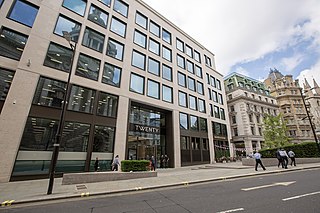
Friends' Provident Insurance was a banking institution founded in 1832 to serve the needs of the Society of Friends (Quakers). Based in Bradford, Yorkshire, it concentrated on sickness and annuity policies until its life fund acquired Century Insurance in 1918, expanding into general insurance. The restriction to Quaker membership was an increasing constraint but the ties were substantially reduced by the Friends' Provident Institution Act 1915. Although Century's branch network enabled FPI to expand, the periodic underwriting losses strained the life fund's capital base and Century was sold in 1975. In the year 2000, Friends Provident demutualised and listed on the FT100 Index. After abortive takeover negotiations, Friends accepted a takeover bid from Resolution Limited in 2009.

Axa S.A. is a French multinational insurance company headquartered in the 8th arrondissement of Paris. It also provides investment management and other financial services.

Norwich Union was the name of insurance company Aviva's British arm before June 2009. It was originally established in 1797. It was listed on the London Stock Exchange and was once a constituent of the FTSE 100 Index.

Samuda Brothers was an engineering and ship building firm at Cubitt Town on the Isle of Dogs in London, founded by Jacob and Joseph d'Aguilar Samuda. The site is now occupied by Samuda Estate.
Standard Life is a life assurance, pensions and long-terms savings company in the UK which is owned by Phoenix Group.

Resolution plc was a UK insurance company headquartered in the City of London. It was listed on the London Stock Exchange and was once a constituent of the FTSE 100 Index but was acquired by the Pearl Group in May 2008.

Royal Insurance Holdings plc was a large insurance business originating in Liverpool but based in London from the early 20th century. It merged with Sun Alliance in 1996 to form the Royal & Sun Alliance Insurance Group.

General Sir Charles Asgill, 2nd Baronet, was a career soldier in the British Army. At the end of the American Revolutionary War he became the principal of the so-called Asgill Affair of 1782, in which his retaliatory death sentence while a prisoner of war was commuted by the American forces who held him, due to the direct intervention of the government of France. Later in his career, he was involved in the Flanders campaign, the suppression of the Irish Rebellion of 1798 and was Commander of the Eastern Division of Ireland during the Irish rebellion of 1803.

Sir Charles Asgill, 1st Baronet merchant banker, was the third son of Henry Asgill, silkman, of St Clement Danes, Middlesex and was educated at Westminster School.

Lady Diana Beauclerk was an English noblewoman and celebrated artist.

MLC was an Australian business that provides investments, insurance and superannuation solutions to corporate, institutional, and retail customers. Due to divestments in the early 21st century, there are now two businesses, with no ownership links, that both use "MLC" in their branding:

The history of insurance traces the development of the modern business of insurance against risks, especially regarding cargo, property, death, automobile accidents, and medical treatment.

Phoenix Group Holdings plc is a provider of insurance services based in London, England. It is listed on the London Stock Exchange and is a constituent of the FTSE 100 Index.

Phoenix Assurance or Phoenix Fire Office was a fire insurance company founded in 1680 in England.
Royal London Asset Management (RLAM) is a UK-based investment management company. RLAM invests across a broad range of core asset classes including fixed income, equities, multi asset, cash and property. It also offers funds that adopt an ethical or sustainable approach.

The Royal London Mutual Insurance Society Limited, along with its subsidiaries, is the largest mutual insurer in the United Kingdom, with Group funds under management of over £150 billion. Group businesses provide around nine million policies and employ 4046 people, as of June 2019.
SunLife Ltd is a UK-based financial services company. Founded in 1810, the company is best known for its range of services for people aged 50 and over.

Sun Alliance Group plc was a large insurance business with its main offices in the City of London and later Horsham. It was created in 1959 by the merger of Sun Insurance, founded in 1710, and Alliance Assurance founded in 1824. In 1996 Sun Alliance merged with Royal Insurance to form the Royal & Sun Alliance Insurance Group.

The Scottish Amicable Life Assurance Society, commonly known as Scottish Amicable, was founded in Glasgow in 1826 and became the sixth largest mutual life assurance institution in the UK with 1.9 million policy holders in the mid-1990s.















